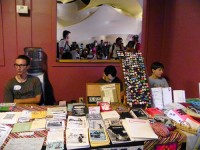The rumblings inside the 11th annual Portland Zine Symposium were nearly overpowered by the rumblings outside. This year, the gathering was held in Southeast Portland at Refuge on Yamhill.
The Zine Scene
The rumblings inside the 11th annual Portland Zine Symposium were nearly overpowered by the rumblings outside. This year, the gathering was held in Southeast Portland at Refuge on Yamhill.
At Refuge, trains rumble by a mere 10 feet away, their clattering just overpowered by the creative spirit that lies inside the building. The larger space, which welcomed hundreds of zine enthusiasts, catered to the larger mass of booths and crowds. In previous years, the gathering was held in the PSU Smith Memorial Student Union and later in the PSU Gymnasium.

“It feels different this year,” said six-time visitor and local zine artist Kinoko Evans.
Zine, a word that entered the English language in the ‘70s, is a shortened version of the word magazine. Zines are essentially small, self-printed works of writing and art. The movement, as we know it now, was inspired by the development of copiers and influenced by the do-it-yourself punk culture on the same period.
The Portland Zine Symposium is an annual event that brings together self-publishers from all walks of life. The bustling crowd that was barely contained inside the building was host to anarchists, comic artists, environmentalists and more, all joined together with one goal in mind: creating and distributing art.
A walk through the booths revealed the variety of content on display. The covers on the zines are as diverse as the people creating them—some are simple sketches of trees and creatures while others feature full-color illustrations. Some common zine themes included Pokémon, nature, music and monsters.
“Some of my themes are female sexuality, opera, male sexuality and political inaction,” said zine creator Angela Roberts. “I started writing in 2008. I lived in Seoul, Korea, and my friends didn’t speak English very well. I did zines to communicate.”
Along with zines, artists also created a variety of other works to sell to the public. Alongside the printed booklets were magnets, stickers, buttons, patches, a variety of knick-knacks and even coloring books.
“I made a coloring book made of people whose race is important to their identity,” said first time “tabler” Hazel Newlevant. “Race is so important, but it’s also such an arbitrary concept at the same time.” Paging through her coloring book, one finds images of Malcolm X, Bruce Lee and Eminem.
While small in size, zines have the ability to be large in meaning.
“I self-publish comics. They’re inspired by mythology, music, life…weird stuff,” explained Newlevant.
Zines are often described as the precursors to blogs. Both allow artists and writers to publish original content for public consumption. Now, with the increased cost of printing, zines are becoming more costly for creators.
“It’s a very effective way to lose money,” Roberts joked.
Yet, there is something undeniably charming about a physical work of art. With the development of blogs as well as the introduction of digital reading devices like the Kindle, the printed word is becoming increasingly rare. Here, creators buy and trade work that can sit on a coffee table rather than just on a hard drive.
Dustin Reese, unlike other artists and writers there, uses multiple media for his creations. Originally a web comic, his cartoon “Plus One” has been compacted into a zine. His comic, which tells the story of two friends who become pregnant, reflects his personal life.
“I’m a parent myself,” Reese said. Endearing and hilarious, the first edition of “Plus Two” follows friends Violet and Desmon from conception to birth.
While some writers dream of being published by large companies, many are content with the freedom self-publishing allows. Without deadlines, editors or compromises, zines are creativity in raw form.
The Zine Symposium, while a meeting place for like-minded publishers, allows for promotion of work to the public. Amongst the crowd wander buyers from the Multnomah County Library, who use the Symposium as an opportunity to stock libraries with copies of local zines.
A time to buy, sell, trade and eat goodies, the gathering was also a time to learn. Workshops offered throughout the day taught lessons in fundraising, story writing, drawing and copying. For those in need to relaxation in the midst of the trains, people, sweat and cookies, there was also an early “Yoga for Zinesters” class to keep the drawing hand limber.
A constantly creative scene, many continued their work even while the symposium was underway. Sketchbooks and notepads lined the laps of those at tables, the creativity never-ending.
While some may assume the zine community is small due to the underground nature of the self-publishing, the crowd that filled the rooms of Refuge indicated otherwise. One can only describe the Portland zine culture as the biggest little scene in town.





Whoever edits and pusihbles these articles really knows what they’re doing.